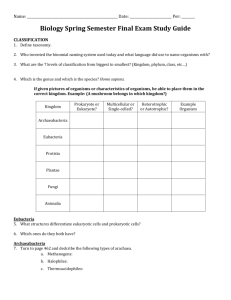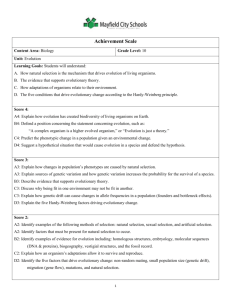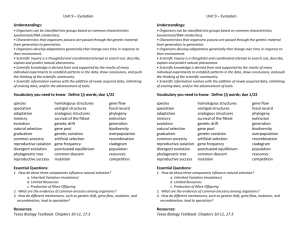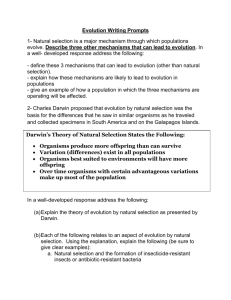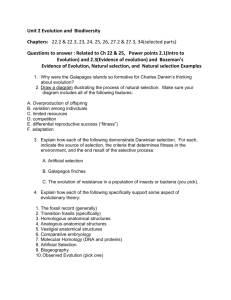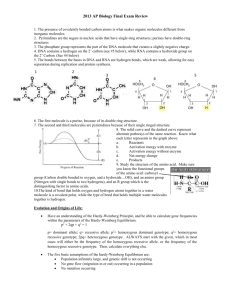Standard 8_ Speciation
advertisement
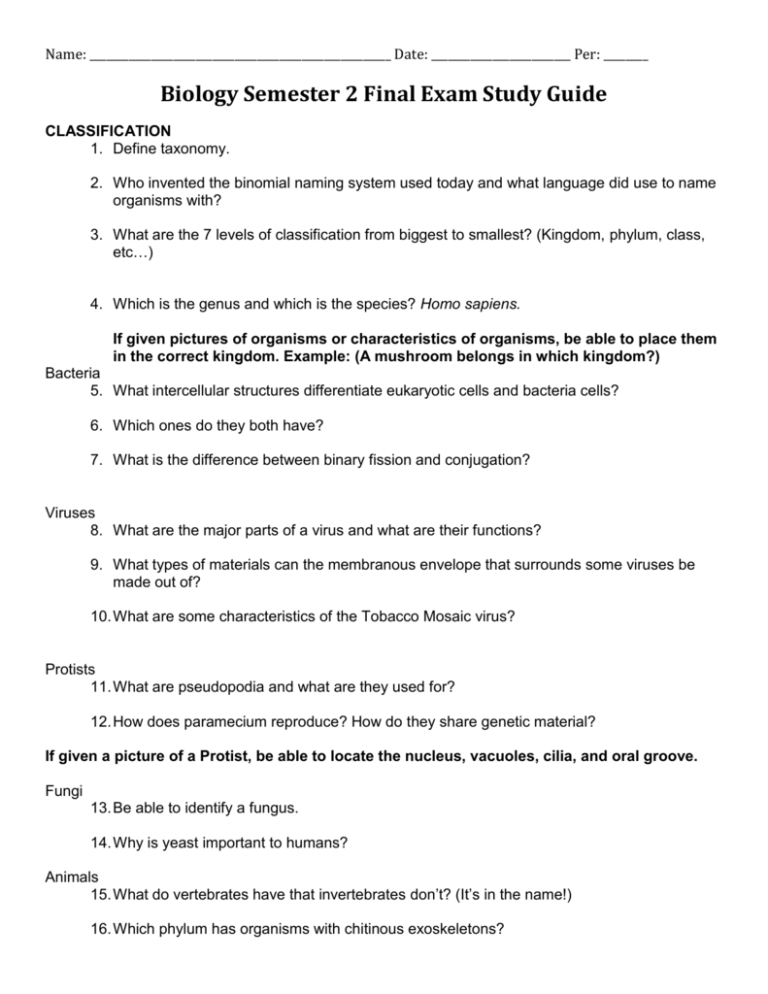
Name: ______________________________________________________ Date: _________________________ Per: ________ Biology Semester 2 Final Exam Study Guide CLASSIFICATION 1. Define taxonomy. 2. Who invented the binomial naming system used today and what language did use to name organisms with? 3. What are the 7 levels of classification from biggest to smallest? (Kingdom, phylum, class, etc…) 4. Which is the genus and which is the species? Homo sapiens. If given pictures of organisms or characteristics of organisms, be able to place them in the correct kingdom. Example: (A mushroom belongs in which kingdom?) Bacteria 5. What intercellular structures differentiate eukaryotic cells and bacteria cells? 6. Which ones do they both have? 7. What is the difference between binary fission and conjugation? Viruses 8. What are the major parts of a virus and what are their functions? 9. What types of materials can the membranous envelope that surrounds some viruses be made out of? 10. What are some characteristics of the Tobacco Mosaic virus? Protists 11. What are pseudopodia and what are they used for? 12. How does paramecium reproduce? How do they share genetic material? If given a picture of a Protist, be able to locate the nucleus, vacuoles, cilia, and oral groove. Fungi 13. Be able to identify a fungus. 14. Why is yeast important to humans? Animals 15. What do vertebrates have that invertebrates don’t? (It’s in the name!) 16. Which phylum has organisms with chitinous exoskeletons? Name: ______________________________________________________ Date: _________________________ Per: ________ 17. What kinds of animals are in the following Phyla: Annelida, Platyhelminthes, Nemaroda, Arthropoda. 18. What are some characteristics of anthropods? Which body part does the legs and wings come from on an insect? 19. How is reproduction usually different on land versus in the water? 20. Define Biology!!!!! EVOLUTION: 1 How old is the earth estimated to be? What are some examples of fossils and how can their age be determined? 2 What gases are thought to be a part of earth’s early atmosphere? 3 Describe Miller and Urey’s experiment and know what they produced with it. 4 Define Natural Selection: 5 Who thought up evolution through natural science? 6 What evidence do we have that evolution occurs? Give 3 answers. 7 What are homologous, analogous, and vestigial structures? What are a few examples of these three types of structures? 8 Using the image to the right; answer the following scenario: Bees prefer pollinating purple flowers. Which genotype(s) will be more common in future generations? 9 Based on your answer to #2 and using the image to the right, explain why Natural Selection acts on phenotype and not genotype for organism survival. Name: ______________________________________________________ Date: _________________________ Per: ________ Gene Pool (Pg. 317-318) Variation/Changing Environment 10 Define Variation: 11 What are some variations for fur color in dogs? 12 List the three main ways that variation in genotype arises. a. b. c. Gene Pool 7. What is the gene pool? 8. Define Allele Frequency: Lethal Alleles in the Gene Pool Sickle Cell Anemia is a recessive blood disease in humans. Homozygous recessive individuals have sickle shaped red blood cells (RBC) and suffer serious health issues. Heterozygous individuals have half normal RBCs and half sickle RBCs; they are healthy and also resistant to the disease Malaria. Homozygous dominant individuals have all normal RBCs but are susceptible to Malaria infection. 9. In terms of evolution, is it favorable/unfavorable to have sickle cell anemia? 10. Malaria infection is a serious risk in Africa, which genotype would survive best? 11. Even though sickle cell anemia is unfavorable to human survival, why does it remain in the human population every generation? (Use the terms homozygous, heterozygous, allele, and gene pool in your answer) Hardy Weinberg (Pg. 320 - 325) 12. Define Genetic Equilibrium: 13. What are the five conditions required to maintain genetic equilibrium? 14. Describe the three types of natural selection and draw a graph showing how each type changes the genetic equilibrium. a. Directional Selection: b. Disruptive Selection: c. Stabilizing Selection: Name: ______________________________________________________ Date: _________________________ Per: ________ Genetic Drift (Textbook Page 322) 1 Define Genetic Drift: Circle the correct answer: 2 The effect of genetic drift is greater as a population (increases / decreases) in size. 3 Genetic drift (increases / decreases) genetic variation in a population. 4 Genetic drift is due to a (natural / random) event. Isolation & Speciation (Textbook Pages 327-330) 5 Describe the two types of isolation: a Geographic: i What is the special name for speciation due to geographic isolation: b Reproductive: i What is the special name for speciation due to reproductive isolation: 6 Whether geographic or reproductive, isolation is basically a barrier between two populations that prevents mating. Why will the barrier eventually lead to speciation if enough time passes? Fossil Evidence (Textbook Page 330) Use the picture to the right to answer the following questions: 7 Which group had the highest biodiversity during the Cenozoic era? 8 Which group went through a short period punctuated equilibrium speciation? 9 Which group is best example of gradualism speciation? 10 Rank the following four periods in terms of their overall biodiversity from smallest to largest: Permian, Pennsylvanian, Tertiary & Triassic Name: ______________________________________________________ Date: _________________________ Per: ________ ECOLOGY: 1 What are the 6 terrestrial biomes? Be able to identify a biome from a picture. 2 What are ecosystems, communities, and populations from an ecological view? 3 How do food chains and food webs work? What do they represent? 4 What are producers, consumers, and decomposers? 5 Where are they represented in a food chain or food pyramid? 6 What are food chains and food webs? 7 What is an energy pyramid? What does each trophic level represent? 8 Define parasitism, mutualism, competition, commensalism, predation and mimicry. Give 1 example of each. 9 Using pages 363-365, Define… a Niche b What happens when niches overlap? c Habitat Use the diagram of an energy pyramid above to answer the following questions (pg. 369). 10 Please note that energy is lost at each level. a The actual energy passed from 1 tropic level to the next equals about _________%. b Name two reasons the amount of energy passed from one tropic level to the next is so low. Name: ______________________________________________________ Date: _________________________ Per: ________ 11 Organisms are classified as producers, consumers, detritivores, or decomposers (pg. 366-369). a How does each obtain energy from the environment? b If only two roles could exist in an en ecosystem, which two would be the most important? Explain. 12 Draw a food chain in the box below labeled “A”. Then draw a food web in the box labeled “B” (pg. 368). A B Use at least 3 organisms... Use at least 6 organisms... 13 What are 3 types of dispersion? Give an example of each. 14 The graph to the right illustrates the growth over several seasons of a population of snowshoe hares that were introduced to a habitat also inhabited by wolves (pg. 385-389). a Which organism is the predator? Which is the prey? b Before the population levels off at the dashed line, how would you describe the birth rate versus the death rate? c Overall, is this an example of a logistic or exponential model of growth? d What is exponential growth and how does “carrying capacity” limit it? e What are some density dependent and independent factors that limit population growth? f Explain why does the line increase then decrease (fluctuate), or cycle, in the graph. Name: ______________________________________________________ Date: _________________________ Per: ________ Ecological Changes 15 Define Biodiversity: 16 What is the green-house effect and what causes it? Explain how each change affects the biodiversity of an ecosystem (pg. 440-444): a Climate change (example - global warming, drought, etc.) b Habitat destruction c Succession (pg. 408-410) Cycling (pg. 371-374) 17 What are the 3 biogeochemical cycles? Be familiar with the gases and processes of each cycle (what happens to oxygen in the carbon/oxygen cycle?). 18 Label the three types of matter that cycle in an ecosystem, using the images below. 1. 2. 3. 19 What two cellular processes keep Carbon and Oxygen cycling between organisms and the atmosphere? 20 What is primary succession and secondary succession? Name: ______________________________________________________ Date: _________________________ Per: ________ HUMAN PHYSIOLOGY If given a picture of the human body, be able to recognize these systems: nervous, muscular, endocrine, digestive, cardiovascular, urinary, skeletal, male and female reproductive, and respiratory. If given pictures of the respiratory, digestive, nervous, urinary, or endocrine, be able to identify the specific organs or parts of organs (i.e. know the parts of the brain). 1. Where is epithelial tissue located? 2. What are some examples of connective tissue? 3. What do arteries, veins, and capillaries do? 4. What are the 4 parts of the blood and what are their functions? 5. Define homeostasis (8) 6. What two systems work together to maintain homeostasis of gases (oxygen and CO2)? 7. How is gas exchanged in the lungs (948)? 8. Name three organs that remove waste (993-998) 9. How do neurons send messages to other neurons and what type of message is it? 10. Explain how each type of feedback adjusts homeostasis (1041-1042): a. Negative Feedback b. Positive Feedback 11. How is communication through the endocrine system different from the way the nervous system communicates?
